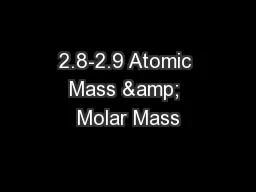

Atomic Mass What is an elements atomic mass The weighted average of its naturally occurring isotopes When looking at an element on the periodic table of elements where is atomic mass found Usually the top left hand corner of each elements box However on the periodic table that you will ID: 720393
Download Presentation The PPT/PDF document "2.8-2.9 Atomic Mass & Molar Mass" is the property of its rightful owner. Permission is granted to download and print the materials on this web site for personal, non-commercial use only, and to display it on your personal computer provided you do not modify the materials and that you retain all copyright notices contained in the materials. By downloading content from our website, you accept the terms of this agreement.
Slide1
2.8-2.9 Atomic Mass & Molar MassSlide2
Atomic Mass
What is an elements atomic mass?
The weighted average of its naturally occurring isotopes
.
When looking at an element on the periodic table of elements, where is atomic mass found?
Usually the top left hand corner of each elements box. However, on the periodic table that you will use for your AP Exam(s), this number will be located below each elements chemical symbol.
How is it calculated? Show all work for the following problem:
Magnesium has three naturally occurring isotopes with masses 23.99
amu
, 24.99
amu
and 25.98
amu
and natural abundances of 78.99%, 10.00% and 11.01% respectively. Calculate the atomic mass of magnesium.
Mg
iso1
+ Mg
iso2
+ Mg
iso3
= (23.99 X .7899) + (24.99 X .1000) + (25.98 X .1101) =
Atomic mass of Mg = 24.31
amu
Slide3
Mass Spectrometry
A technique that separates particles according to their mass.
Can be used to identify atoms that make up a molecule, and the percent abundances of isotopes of an element.
After a sample is ionized, and the ions travel through the mass spectrometer, they strike a detector that puts out signals, and ultimately produces a mass spectrum of the sample to be analyzed. Slide4
Mass Spectrum of Boron
Boron has an atomic mass of around 10.8
amu
If you analyze this spectrum you can see that there are two lines, the larger at 11
amu
. (m/z = mass charge ratio)
The two lines indicate that boron, which is monatomic, has two isotopes boron-10 and boron-11.
On the following page, we will use the spectrum to calculate boron’s atomic mass:Slide5
Mass Spectrum of Boron (Continued)
First, we need to calculate relative abundance:
Abundance of B-10 = 25.0% / (25.0% + 100.0%) = 20.0%
Abundance of B-11 = 100.0% / (25.0% + 100.0%) = 80.0%
Next, let’s calculate atomic mass:
B atomic mass = (.2000 X 10) + (.8000 X 11) = 10.8
amu
Slide6
Avogadro’s Number
What is
A
vogadro’s number, and how does it get its specific value?
6.022x10
23
mol
-
(You don’t need to memorize this number) is equal to the amount of atoms in 12.0 g of pure carbon 12.Slide7
Mole Conversions (atoms to moles)
A pure silver ring contains 2.80X10
22
silver atoms. How many moles of silver atoms does it contain?
2.80X10
22
atoms Ag 6.022x10
23
atoms Ag
------------------------------ = ------------------------------
X 1.00
mol
Ag
X = 4.65x10
-2
mol
AgSlide8
Molar Mass and mass to mole conversions
Molar mass g/
mol
= Atomic mass in
amu
Example: carbons molar mass = 12.01 g/
mol
carbon’s atomic mass = 12.01
amu
12.01 g carbon = 1 mol carbon = 6.022X10
23
atoms carbon
Calculate the number of moles of copper in 35.8 g pure copper.
35.8 g Cu 63.55 g Cu
--------------- = --------------------
X = 5.63X10-1 mol Cu X 1.00 mol CuSlide9
Mole Conversions (atoms to mass)
Calculate the mass of 2.25X10
22
tungsten atoms.
This is a two step problem:
First, convert atoms to moles:
2.25X10
22
atoms W 6.022X10
23
atoms W
---------------------------------------- = ------------------------------------------------
X = 3.74X10
-2
mol
W
X 1.00 mol WNext, convert moles to atoms
3.74X10
-2
mol
W 1.00
mol
W
----------------------------------------
= ------------------------------------------------
X
= 6.87 g W
X
183.8 g WSlide10
Pgs.
81-82 #’s 76, 80, 82, and 91.
Study for Chapter 2 Quiz